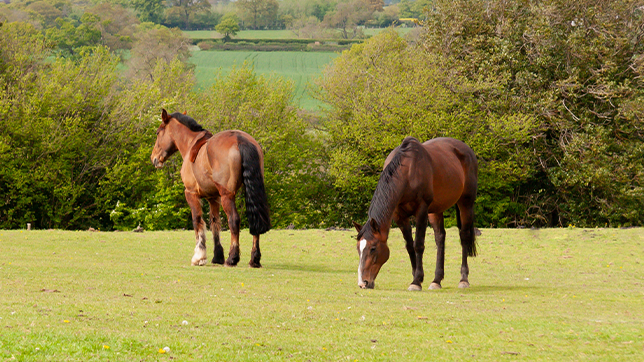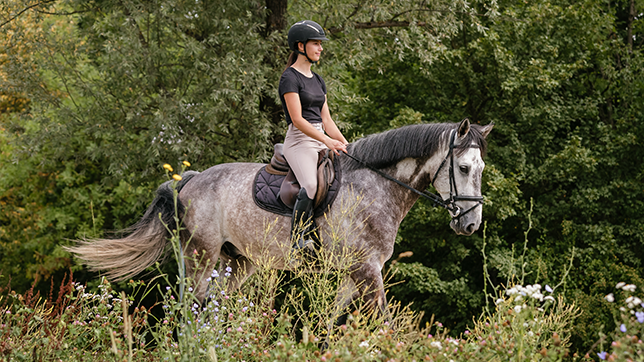19th April 2024
Caring for wildlife and nature is everyone’s responsibility. Though did you know that as a horse owner, you’re in a unique position to have a truly positive impact on the nature in your (horse’s) neighbourhood?
As horse owners, we spend much of time in nature – whether we’re braving the elements to care for our horses, riding along glorious countryside bridlepaths, or visiting the beach. Thankfully, there are actions we can take to nurture nature and protect the wildlife around us, while helping our horses stay happy and healthy in the process.
Even the tiniest action can have a big impact. So, read on to discover the many ways you can make a wonderful difference to wildlife and nature…
Top 10 wildlife- and nature-friendly field management practices
Field management is arguably the most significant way we can influence nature while caring for our horses. Check out our top 10 tips for managing your horse’s field and how to give nature a helping hand…
Fence off a small, wildlife-friendly area
Fencing off a small section of your horse’s field to plant wildflowers (or letting grasses grow naturally) can provide for pollinators, like bees and butterflies, from April until November. Even this seemingly small action creates a vital space for wildlife, yet it also has the benefit of preventing horses from being cornered by other horses in the field!
An alternative to fencing off a corner of the field could be sectioning off part of a stream, if there’s one in your horse’s field, and returning it to nature. Provided your horse can’t access the area to leave droppings, letting plants grow along the water’s edge could improve water quality downstream, too.
Important: Be mindful when planting wildflowers, by choosing species that aren’t harmful to your horse. We recommend visiting our guide to poisonous plants and having a chat with your vet before planting anything in your horse’s field.
Avoid spraying herbicides
Herbicides are chemical products used to destroy weeds.
Instead of using artificial herbicides to kill weeds in your horse’s field, pull up weeds by hand and/or cross-graze with other species who can safely eat most plants (e.g. sheep).
If there’s an abundance of weeds in your horse’s field, and you can’t avoid spraying herbicides, opt for ‘spot spraying’ specific plants instead of spraying the entire field.
Don’t use artificial fertiliser
Fertiliser is formulated to promote plant growth. However, artificial fertiliser can be harmful to wildlife and could cause excessive grass growth that can lead to horses getting laminitis, so we don’t recommend using it on your fields. Though if you do need to fertilise fields, organic fertiliser is more environmentally friendly and may restore the balance of key nutrients in the soil.
Please note: We advise against using manure as fertiliser on grazing pasture, since it not only increases the risk of worms in horses, but also ruins grass quality. Check out our article about worming horses, for further field management advice.
Be mindful when rolling and harrowing fields
‘Rolling’ a field helps to flatten out any areas that are uneven, due to the damage caused by hooves. The process of rolling involves levelling a field using heavy, metal, cylinder-shaped machinery that’s usually pulled by a tractor or quad bike, depending on its size.
Using heavy roller machinery can prevent fields from draining properly, so it’s worth choosing a gentler roller (e.g. disc roller), to smooth your horse’s field without damaging the soil.
‘Harrowing’ is a process that involves dragging specially designed, spiked machinery across a field to remove weeds and mole hills, while also improving soil quality and water drainage. Some horse owners use a chain harrow towed by a quad bike when harrowing their fields, whereas others employ someone to harrow fields using industrial farm equipment instead.
When harrowing your horse’s field, it’s important to do so in late winter or very early spring, before grass starts to grow, to avoid disturbing nesting birds.
Use hedges around field perimeters
Where possible, as an incredibly valuable resource to birds and other wildlife, you could plant native British hedges around the perimeters of every field. To prevent your horse from eating toxic plants that may grow in hedges, and to protect hedges from damage, it’s worth using post and rail fencing as a barrier.
Plus, hedges provide natural shelter from wind and rain for your horse!
Avoid overgrazing fields
Allowing fields to be grazed until there’s barely a blade of grass decreases the field’s value to wildlife and has a negative impact on your horse’s turnout time.
To avoid damaging fields through overgrazing, you’ll need to rotate the fields your horse uses for turnout.

Don’t turn your horse out onto muddy, wet fields
A field that’s ‘poached’ has been severely damaged by overgrazing and/or its quality has been broken down over time by the impact of horses’ hooves.
Not only do poached, muddy fields cause mud fever, but they can also become waterlogged and ruin the soil – preventing grasses and other wildlife-friendly plants from growing.
Consider adding different plant species around the edges of fields
Improve biodiversity by creating mini ‘wildlife corridors’ between fields, where there’s double-fencing – though make sure the plants you choose are horse-friendly!
Leave fallen branches in areas that are inaccessible to horses
Fallen branches can become fantastic habitats for insects, yet it’s important to move any fallen branches or damaged sections of trees out of your horse’s field.
Poo pick grazing pasture daily
Clearing your horse’s field of droppings every day will protect your horse from parasites, while preserving grass quality for the benefit of both your horse and wildlife.
Locate muck heaps away from water sources
Keep muck heaps away from water sources, like rivers and streams, to avoid contaminating vital natural resources.
Make your stable yard more wildlife-friendly
Creating wildlife-friendly spaces around the stable yard is easier than you might think!
Put up nest boxes around the stable yard
Nest boxes can provide safe spaces for wild birds, and they’re usually inexpensive to buy or make yourself.
Alternatively, you could put a bird bath somewhere out of reach of farm cats and horses.
Create herb gardens on any unused patches of grass
Should there be unused patches of grass, or pot-sized spaces left empty around the yard, you could plant pollinator-friendly, horse-safe flowers to support local biodiversity.
Avoid wasting resources
Fix any water leaks promptly and turn lights off when they’re not in use. It’s estimated that around 900 million litres of clean drinking water is lost to household leaks every day – which would otherwise supply 1 million people with water each week.
Water is one of our most precious natural resources, so wasted water has a negative impact on the sustainability of our water supplies.
Use solar power where possible
You could use solar energy to power small appliances in your livery yard’s communal kitchen or tearoom.
Set up a recycling scheme
If you keep your horse at a livery yard, inspire people to band together and donate unwanted equestrian items to local charities (e.g. twice a year), to reduce waste.
Alternatively, you could encourage fellow liveries to recycle, up-cycle, or reuse items instead of throwing them away, e.g. old horse rugs.
Protecting wildlife and nature while hacking with your horse
Extend your nature-friendly actions to your time in the saddle, by protecting wildlife while out hacking with your horse in the following ways…

Follow designated bridlepaths
So as not to damage vital plants and wildlife habitats, follow designated bridlepaths.
Think carefully before jumping hedges and fences
While out and about with your horse, avoid jumping fences or hedges that aren’t specifically set-up to be used as jumps – to protect wild birds who may be nesting.
Avoid riding through sand dunes or saltmarshes, unless following a bridlepath
When riding near sand dunes or saltmarshes, it’s essential to stay on bridlepaths – otherwise you could cause damage to natural sea defences, as well as harm rare wildlife and plants. Additionally, when riding on the beach, please don’t disturb flocks of wading birds.
As you can see, there are countless ways to care for wildlife and biodiversity as a horse owner. We’d love to hear all about your nature-saving efforts – please let us know your ‘tails’ of UK wildlife via Facebook or Instagram!
Animal welfare blog
If you found this blog useful, why not visit our animal welfare blog to find more articles about animal at risk around the world?
From news and facts, to charities helping protect animals and the great work they do - find out more about animal welfare and those making a difference.
Charities we support
Every year we donate hundreds of thousands of pounds to charities - find out more about the charities we support.
